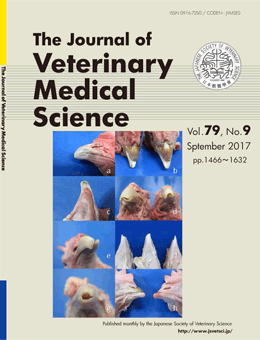Vol.79, No.9 September 2017

Explanation of the cover photograph
Morphologically abnormal beaks observed in chickens that were beak-trimmed at young ages
Yuki YAMAUCHI et al. (pp. 1466-1471)
Beak trimming, which has recently been debated from an animal welfare perspective as it causes pain and stress to the birds, has long been practiced on poultry, mainly on egg-laying hens, to prevent injurious feather and vent pecking (cannibalism) and/or to reduce the spilling of feed. Of various beak trimming methods, the most common ones involve removing the distal 1/3 of the beak or leaving at least 2 mm from the nostrils at up to 10-days of age, by using a hot blade or infrared rays. Beak-trimmed chickens are prone to uneven growth of the upper and lower mandibles, deformation of the beak tip, and abnormal beak occlusion as they age.
Figure shows some examples of morphologically abnormal beaks observed in beak-trimmed chickens at a processing plant. a: a normal beak; b: uneven growth resulting in a longer lower mandibles; c: uneven growth resulting in a longer upper mandibles; d: beaks showing abnormal occlusion; e: a beak with crossed mandibles; f: sharp edged mandibles; g: permanent open beak; h: tubercular swellings at the tips of the lower mandibles.
This number is available on J-STAGE
https://www.jstage.jst.go.jp/browse/jvms/79/9/_contents